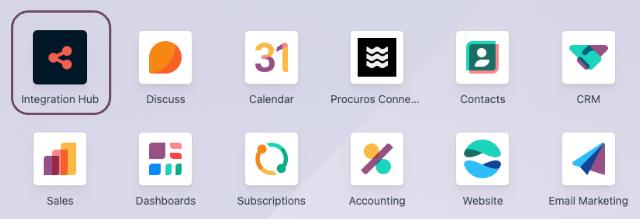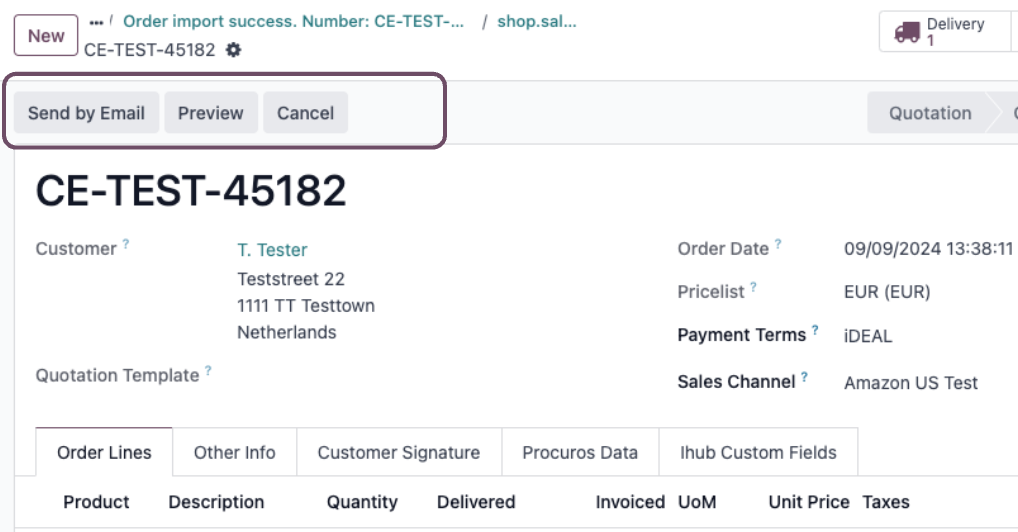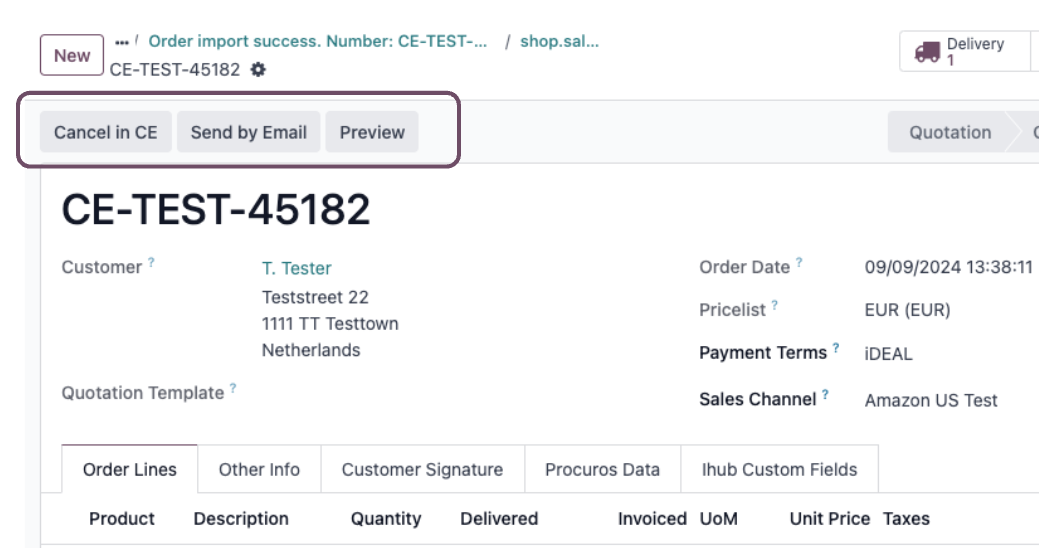ChannelEngine <> Odoo integration: User Documentation
The following documentation will provide you with the information you need to use the much. ChannelEngine <> Odoo 17 integration. The objective is to get you familiarised with the integration by providing relevant information as to the main business processes it covers, and how you can configure it to best suits your needs.
Do you need support with our module? Open a ticket
Quick start guide
Module dependencies
For the ChannelEngine - Odoo integration to be used, please make sure that you have in your database :
1. The following Odoo standard modules :
- Sales
- Invoicing
- Accounting
- Inventory
2. The following much. modules :
- Integration Hub
- Order base integration
- Much notify
Install the much. ChannelEngine integration
- Go to Odoo > Apps and search for ChannelEngine.
- Select all related modules and click Activate.
- Go to Integration Hub > Integrations and click New.

- Add an integration name.
- In the Integration Type field, select ChannelEngine.
- In the Company field, select the Odoo company that this integration will be applied to.
- Click Save.

In Integration Hub > Settings, make sure you have the following settings enabled :
- iHub Logs
- iHub Mappers
Enable the ChannelEngine - Odoo integration
1. Retrieve your ChannelEngine API credentials
- Login to your ChannelEngine account
- Go to Settings > Merchant API Keys.
- Click Add and give the key a name.
2. Enable the integration in Odoo
- Go back to Odoo.
- Go to Integration Hub > Integrations > ChannelEngine > Integration Settings.
- In the Url field, paste your ChannelEngine Url - ex : https://companyname.channelengine.net/
- In the API key field, paste your ChannelEngine API key.
- Save.
- Back to Integration Hub > Integrations > ChannelEngine, click Enable Integration.

Synchronise your first product
Before you start synchronising products, navigate to Integration Hub > ChannelEngine >Integration Settings>Product settings and select the Default Pricelist to be used by the connector.
1. Odoo to ChannelEngine (Export)
- In Odoo, go to Sales > Products.
- Open the product of your choice, open the ⚙️ action menu and click Export to connectors.

- Select ChannelEngine from the drop down menu and click Execute.
- A pop-up appears, informing you of the successful export of the product to ChannelEngine. You can also navigate to Integration Hub > ChannelEngine > Logs to visualise the log associated with your recently exported product. The product can also be found in the integration Products smart button.

2. ChannelEngine to Odoo (Import)
- In ChannelEngine admin, go to Products > Products and select the product you would like to import to Odoo.
- In the product page, copy the Merchant product number.
- In Odoo, navigate to Integration Hub > ChannelEngine and click the Import button.

- In the Resource field, select Products.
- If your product already exists in Odoo, select the Update existing products option.
- In the Merchant ProductNo field, paste the Merchant product number from ChannelEngine.
- Click Execute.
- Click on the Logs or Products smart button to access your newly imported product.
Import your first order
- In ChannelEngine, go to Orders > Overview and select the order you would like to import to Odoo.
- In the order page, copy the Channel Order ID.
- In Odoo, navigate to Integration Hub > CE and click the Import button.
- In the Resource field, select Orders.
- In the Channel order ID, paste the Channel order ID from ChannelEngine
- Click Execute.
- Click on the Logs or Orders smart button to access your newly imported order.

ChannelEngine <> Odoo workflows
In this section, you will learn how to use the integration in your daily workflows.
Automated product synchronisation
1. ChannelEngine to Odoo (Import)
By default, the integration will automatically import new products from ChannelEngine to Odoo, on a daily basis.
To modify this scheduled action, you can go to Integration Hub > ChannelEngine and click the Scheduled Actions smart button at the top of the page.

If you want the scheduled action to also automatically update existing products in Odoo when a modification is made in ChannelEngine :
- Go to Integration Hub > ChannelEngine > Integration Settings
- In the Product Settings tab, check the Update Existing Products option.
- Save your changes.
2. Odoo to ChannelEngine (Export)
There is no scheduled action that automatically exports your products to ChannelEngine.
If you manage your product information in Odoo, products must have been exported manually to ChannelEngine at least once to enable automatic updates.
To automatically reflect in ChannelEngine updates that you might do on your products in Odoo :
- Go to Integration Hub > CE > Integration Settings
- In the Product Settings tab, check the Export on save option.
- Save your changes.
The option enables real-time updates of your products (template or variants) in ChannelEngine when you make changes and save them in Odoo.
Archiving/Deleting a product
When a product is no longer going to be used in Odoo and Channel Engine it can be archived/deleted. To archive/delete a product follow the instructions:
- Open a product in Odoo.
- Go to the “Actions” menu and click “Archive”.
Archiving a product triggers the delete API action, therefore, the product will be deleted in Channel Engine.
To reactivate the product, do the same process but unarchive the product.
Automated order import
By default, the integration will automatically import new orders from ChannelEngine to Odoo, on a daily basis.
To modify this scheduled action, you can go to Integration Hub > ChannelEngine and click the Scheduled Actions smart button at the top of the page.

To ensure the automated order workflow happens seamlessly, you first need to configure the integration default order settings. To do so, navigate to Integration Hub > ChannelEngine > Integration Settings > Sales Settings.
Default Sales Settings
* fields are mandatory
- Sales team and Sales person : define a default sales team or person to be assigned to incoming orders.
- Warehouse* : define the default warehouse where your products are located. This setting will be overwritten if the Products are configured to be in a different warehouse.
- Locations* : define the default location for delivery orders within the default warehouse
- Shipping policy* : choose whether you would like to ship an order as soon as possible, meaning that the order should have multiple shipment based on product availability, or if you prefer to ship an order in one shipment when all product are ready
- Shipping method* : define a default shipping method for your incoming orders.
- Set prefix before order : this allows you to differentiate orders coming from CE by adding a prefix before the order ID. You can for example use CE as a prefix.
Default Sales Workflows
- Confirm order on import : by activating this option, all incoming orders will be confirmed automatically, which will trigger the creation of a delivery order for your warehouse to ship the order.
- Create invoice on order import : by activating this option, all incoming orders will trigger the creation of an invoice.
Default Channel Settings
For each of the channel (marketplace) that are active in ChannelEngine, you can configure the following :
- Sales team and Sales person : define a default sales team or person to be assigned to incoming orders from a specific channel. This will override the one defined in the Sales Settings.
- Language : updates customer's language in the contact model.
- Journal : configure the journal where invoices and credit notes related to a specific channel should be recorded.
- Channel Warehouse : default warehouse to be used in stock moves when the orders are fulfilled by the marketplace.
- API key : required for some functionalities in some marketplaces.
Default Channel Workflow
- Allow Partial Cancellation : if checked, this feature allow to cancel an order only partially. Odoo standard cancellation feature only allows to cancel the full order.

Without Partial Cancellation

With Partial Cancellation
After configuring all these settings, click Save.
When the scheduled action will run, all your orders since the last import date will be imported in Odoo. Logs will be created for each successful and unsuccessful import, and the orders will be visible in the integration Orders smart button.
Automated product stock export
After an order is imported and confirmed, the stock of the included products is updated in the Odoo Inventory App based on the quantities ordered.
To keep your shop up-to-date on products stock, the integration will :
- Automatically export product stock on order shipment export (see next section)
- Automatically export product stock on a daily basis.
To modify this scheduled action, you can go to Integration Hub > CE and click the Scheduled Actions smart button at the top of the page.
Automated shipment export
After the orders are imported, the order fulfilment needs to be taken into consideration. There are usually two main cases:
- Fulfillment by marketplace
- Fulfillment by merchant.
In the first case, no shipment is considered in Odoo since it is taken care of by the marketplace. Therefore, the order is already created in ChannelEngine as Shipped, and in Odoo, order confirmation and stock moves are directly applied.
In the second case, the integration will automatically export shipment on a daily basis.
To modify this scheduled action, you can go to Integration Hub > ChannelEngine and click the Scheduled Actions smart button at the top of the page.

Order shipment can also be exported in real-time. To activate this option :
- Go to Integration Hub > ChannelEngine > Integration Settings
- In the Product Settings tab, check the Auto-export Shipment option.
- Save your changes.
Automated invoice export
After sales orders are imported and confirmed, the orders need to be invoiced. Invoice creation can be done manually or automatically (as seen in the Automated order import section).
The integration will automatically export posted invoices to ChannelEngine on a daily basis.
To modify this scheduled action, you can go to Integration Hub > ChannelEngine and click the Scheduled Actions smart button at the top of the page.
Order cancellation synchronisation
Orders can be canceled on multiple sides, i.e., marketplace, Channel Engine and Odoo. Orders are usually canceled by the customer on the marketplace, therefore, the information would only need to be imported. However, the process to cancel orders in Channel Engine and Odoo is described, including importing cancellations, to include all scenarios
Import cancellation from ChannelEngine
- Go to Integration Hub > ChannelEngine and click Import.
- In the resource field, select Cancellation.
- If you want to import specific cancellations, use the order ids field.
- If you want to import all cancellations for a time range, use the From Date To Date fields.
- Click Execute.
Export cancellation from Odoo
- Go to a confirmed sales order.
- Click on Cancel - The cancellation will be automatically exported to ChannelEngine
Order return synchronisation
After order fulfilment, an order can be returned. The integration allows returns to be imported into Odoo when the return has already been created in the Channel Engine and the status is “Shipped”.
Import returns from ChannelEngine
The integration will automatically export returns on a daily basis.
To modify this scheduled action, you can go to Integration Hub > ChannelEngine and click the Scheduled Actions smart button at the top of the page.
Returns can also be imported using the Import wizard. To do so :
- Go to Integration Hub > ChannelEngine and click Import.
- In the resource field, select Returns.
- If you want to import specific returns, use the order ids field.
- If you want to import all returns for a time range, use the From Date To Date fields.
- Click Execute.
Once the return imported, a reverse picking will be created for the returned products. You can access the latest returns by going in the ChannelEngine integration Logs.
Export returns from Odoo
- Go to the delivery order of the order you want to return.
- Select the products that are to be returned.
- Click Return - this will automatically export the return to ChannelEngine.
Multi-company support
If you are using Odoo with multiple companies, you can simply create a new integration for each of the companies you want to use the ChannelEngine integration for. You can select the company in the New Integration form.
Multi-instance support
If you want to integrate Odoo with multiple ChannelEngine instances, you can simply create a new integration for each instance. You can fill the connection settings of each instance after creating the integration.